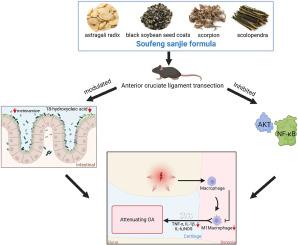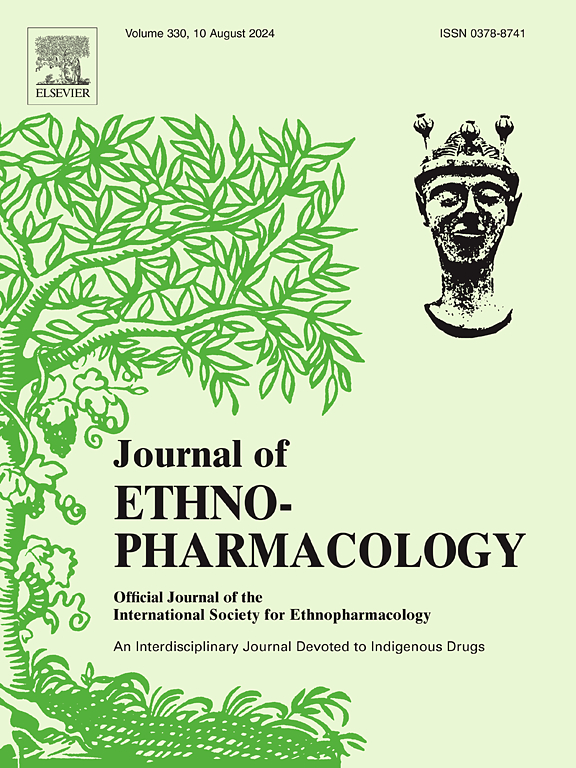Soufeng sanjie formula alleviates osteoarthritis by inhibiting macrophage M1 polarization and modulating intestinal metabolites
IF 5.4
2区 医学
Q1 CHEMISTRY, MEDICINAL
引用次数: 0
Abstract
Ethnopharmacological relevance
Osteoarthritis (OA) is defined as “bone bi” disease based on clinical symptoms in Chinese medicine. Soufeng sanjie formula (SF) is a traditional formula for treating “bone bi” disease, which consists of Scolopendra (dried body of Scolopendra subspinipes mutilans L. Koch) (0.5 g), Scorpions (dried body of Buthus martensii Karsch) (0.5 g), Astragali radix (dried root of Astragalus membranaceus (Fisch.) Bge) (20 g) and Black soybean seed coats (seed coats of Glycine max (L.) Merr) (30 g), and it can be used to treat rheumatoid arthritis. Nonetheless, the potential of SF to postpone the advancement of OA and its underlying mechanisms remain unexplored.
Aim of the study
This study investigated whether SF could alleviate OA and the underlying mechanisms.
Materials and methods
Anterior cruciate ligament transection (ACLT) was performed to establish an OA mice model. Mechanical pain and cold pain were assessed to evaluate changes in pain sensitivity in OA mice. Micro-CT was used to observe the microstructure and quantify the bone morphological parameters of knee joints. Safranin O-fast green staining was used to evaluate cartilage damage, and Osteoarthritis Research Society International (OARSI) scores were calculated. Immunohistochemistry was used to assess the expression of inflammatory factors in the synovium of OA mice following SF administration. Immunofluorescence analyzed the fraction of CD80 and iNOS positive regions in the synovium of knee joints. The effect of SF on macrophage M1 polarization was investigated using flow cytometry, western blot and quantitative PCR (qPCR) in vitro. Untargeted metabolomics was used to identify the differential metabolites associated with OA.
Results
SF-treatment markedly reduced the cartilage damage, lowered the OARSI score and downregulated the pain sensitivity in the OA mice. Secondly, SF decreased the expression of IL-6, IL-1β, and TNF-α in the OA synovium. SF also reduced the percentage of CD80 and iNOS in the synovium of the knee joint after ACLT surgery by immunofluorescence. Thirdly, SF inhibited the protein expression of iNOS and COX-2, decreased the percentage of CD80, and reduced the mRNA levels of IL-6, IL-1β, and TNF-α in BMDM cells. Furthermore, SF inhibited the macrophage M1 polarization-related AKT/NF-κB signaling pathway. Finally, untargeted metabolomics showed that SF effectively reduced the levels of intestinal metabolite 18-hydroxyoleic acid in OA mice.
Conclusion
Our results suggested that SF reduced pain symptoms and joint inflammation in mice with OA. Furthermore, SF inhibited synovial macrophage M1 polarization and modified the levels of the pro-inflammatory intestinal metabolite 18-hydroxyoleic acid in OA mice. Therefore, SF may be act as a potential Chinese medicine for the treatment of OA.

搜风散结方通过抑制巨噬细胞 M1 极化和调节肠道代谢物缓解骨关节炎。
民族药理学意义:中医根据临床症状将骨关节炎(OA)定义为 "骨偏 "病。搜风散结方是治疗 "骨偏 "病的传统方剂,由葶苈子(Scolopendra subspinipes mutilans L. Koch 的干燥体)(0.5 克)、全蝎(Buthus martensii Karsch 的干燥体)(0.5 克)、黄芪(黄芪(Astragalus membranaceus (Fisch.) Bge 的干燥根)(20 克)和黑大豆种皮(Glycine max (L.) Merr 的种皮)(30 克),可用于治疗类风湿性关节炎。然而,SF 延缓 OA 恶化的潜力及其内在机制仍有待探索:研究目的:本研究探讨了 SF 能否缓解 OA 及其内在机制:材料与方法:通过前交叉韧带横断(ACLT)建立 OA 小鼠模型。对机械痛和冷痛进行评估,以评价 OA 小鼠疼痛敏感性的变化。使用显微 CT 观察膝关节的微观结构并量化骨形态学参数。Safranin O-快绿染色用于评估软骨损伤,并计算国际骨关节炎研究学会(OARSI)的评分。免疫组化法用于评估给药 SF 后 OA 小鼠滑膜中炎症因子的表达。免疫荧光分析了膝关节滑膜中 CD80 和 iNOS 阳性区域的比例。在体外使用流式细胞术、Western 印迹和定量 PCR(qPCR)研究了 SF 对巨噬细胞 M1 极化的影响。非靶向代谢组学用于鉴定与 OA 相关的不同代谢物:结果:SF 治疗显著减少了 OA 小鼠的软骨损伤,降低了 OARSI 评分,并下调了疼痛敏感性。其次,SF 降低了 OA 滑膜中 IL-6、IL-1β 和 TNF-α 的表达。通过免疫荧光法,SF 还能降低 ACLT 术后膝关节滑膜中 CD80 和 iNOS 的比例。第三,SF抑制了iNOS和COX-2的蛋白表达,降低了CD80的比例,并降低了BMDM细胞中IL-6、IL-1β和TNF-α的mRNA水平。此外,SF 还抑制了巨噬细胞 M1 极化相关的 AKT/NF-κB 信号通路。最后,非靶向代谢组学研究表明,SF改变了OA小鼠肠道内容物的代谢谱,导致促炎代谢物18-羟基油酸水平升高,而SF能有效降低该代谢物的水平:我们的研究结果表明,SF 可减轻 OA 小鼠的疼痛症状和关节炎症。此外,SF 还能抑制 OA 小鼠滑膜巨噬细胞 M1 极化,并改变肠道促炎代谢物 18- 羟基油酸的水平。因此,顺参可作为一种潜在的中药用于治疗 OA。
本文章由计算机程序翻译,如有差异,请以英文原文为准。
求助全文
约1分钟内获得全文
求助全文
来源期刊

Journal of ethnopharmacology
医学-全科医学与补充医学
CiteScore
10.30
自引率
5.60%
发文量
967
审稿时长
77 days
期刊介绍:
The Journal of Ethnopharmacology is dedicated to the exchange of information and understandings about people''s use of plants, fungi, animals, microorganisms and minerals and their biological and pharmacological effects based on the principles established through international conventions. Early people confronted with illness and disease, discovered a wealth of useful therapeutic agents in the plant and animal kingdoms. The empirical knowledge of these medicinal substances and their toxic potential was passed on by oral tradition and sometimes recorded in herbals and other texts on materia medica. Many valuable drugs of today (e.g., atropine, ephedrine, tubocurarine, digoxin, reserpine) came into use through the study of indigenous remedies. Chemists continue to use plant-derived drugs (e.g., morphine, taxol, physostigmine, quinidine, emetine) as prototypes in their attempts to develop more effective and less toxic medicinals.
 求助内容:
求助内容: 应助结果提醒方式:
应助结果提醒方式:


